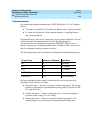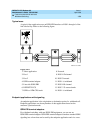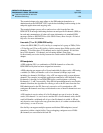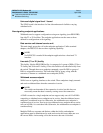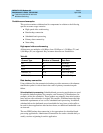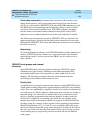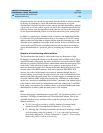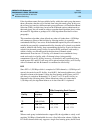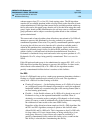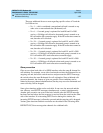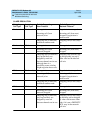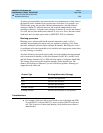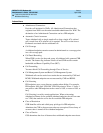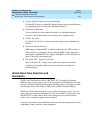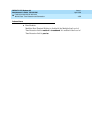
DEFINITY ECS Release 8.2
Administrator’s Guide
555-233-506
Issue 1
April 2000
Features and technical reference
1596Wideband Switching
20
scheme supports four (T1) or five (E1) fixed starting points. The H0 algorithm
searches for an available quadrant within a facility based on the direction of trunk
or hunt administered. If the algorithm cannot find an available quadrant within any
facility allocated to this trunk group, then the call is blocked from using this trunk
group. Again, based on GRS administration, the call may route to a different trunk
group preference and be subject to another algorithm based on the wideband
options administered.
This same trunk or hunt algorithm, when offered any narrowband or N x DS0 call,
attempts to preserve idle quadrants by choosing a trunk(s) in a partially
contaminated quadrant if one exists. If a partially contaminated quadrant capable
of carrying the call does not exist, then the call is placed on available trunk(s)
within an idle quadrant, thus contaminating the quadrant. Again, facilities are
selected via the trunk group’s facility list and with PN preference, and a trunk(s)
within a facility is selected based on the direction administered. Note that a
D-channel is considered a busy trunk and results in the top most quadrant of a T1,
B-channels 19 to 24, always being partially contaminated. This is not true for
NFAS.
If this H0 optioned trunk group is also administered to support H11, H12, or N x
DS0, then this algorithm also attempts to preserve idle facilities. In other words,
when offered a narrowband, H0, or N x DS0 call, the algorithm searches
partially-contaminated facilities before it searches to idle facilities.
N x DS0
For the N x DS0 multi-rate service, a trunk group parameter determines whether a
floating or a flexible trunk allocation scheme is to be used. The algorithm to
satisfy an N x DS0 call is either floating or flexible.
■ Floating (Contiguous) — In the floating scheme, an N x DS0 call is placed
on a contiguous group of B-channels large enough to satisfy the requested
bandwidth without any constraint being put on the starting channel (that is,
no fixed starting point trunk).
■ Flexible — In the flexible scheme, an N x DS0 call is placed on any set of
B-channels as long as the requested bandwidth is satisfied. There is
absolutely no constraint such as contiguity of B-channels or fixed starting
points. Of course, as with all wideband calls, all the B-channels comprising
the wideband call must reside on the same ISDN facility.
Regardless of the allocation scheme employed, the N x DS0 algorithm, like
the H11 and H12 algorithms, attempts to preserve idle facilities when
offered B, H0, and N x DS0 calls. This is important so that N x DS0 calls,
for large values of N, have a better chance of being satisfied by a given
trunk group. However, if one of these calls cannot be satisfied by a
partially-contaminated facility and an idle facility exists, a trunk on that
idle facility is selected, thus contaminating that facility.



